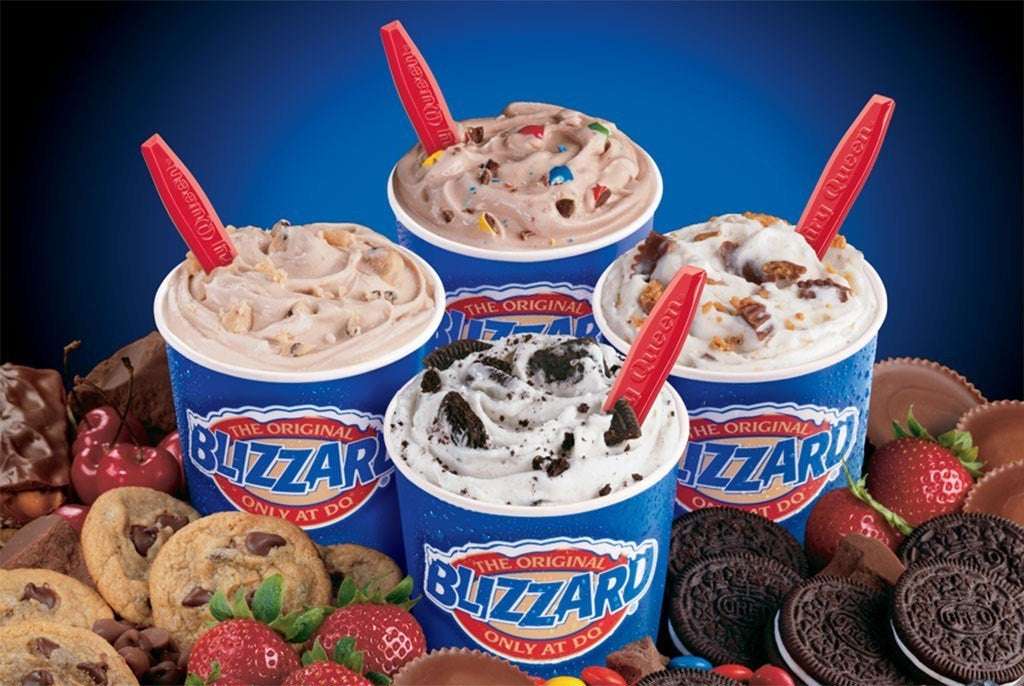Scan the menu at your local Dairy Queen, and you'll spot blizzards, cones, parfaits, banana splits, shakes, and malts. But noticeably absent from the menu? Ice cream!
File this in the "weird, but true" category: Dairy Queen's frozen treats aren't actually ice cream. The reason comes down to some good ole' technicalities from the Food and Drug Administration. While fancier ice cream companies are ramping up the milkfat content in their products, Dairy Queen is sticking with its original recipe. As it turns out, the fast food chain doesn't use enough milkfat for its Blizzards, ice cream cones, and other treats to meet the FDA's official ice cream qualifications.
Why isn't Dairy Queen soft serve ice cream?
To earn an "ice cream" categorization, a product must have a minimum milkfat (or butterfat, as DQ calls it) content of 10%. DQ's soft serve, meanwhile, has just five percent milkfat.
"Technically, our soft serve does not qualify to be called ice cream," the Dairy Queen site fesses up. The company also explains that its famous soft serve once fell into the FDA's category of "ice milk." But the FDA scrapped that category of product to allow companies to market their frozen dairy products with lower milkfat content using terms like "low-fat" and "reduced fat."
Dairy Queen's soft serve does fit into the FDA's "reduced-fat" category, and its shake mix would count as "low-fat," the company website explains, but the company has never marked it that way.
RELATED: No-sugar-added recipes you'll actually look forward to eating.
Does that mean DQ treats are healthy?
Nope! Even though they have a lower butterfat content, that doesn't mean Dairy Queen products are fat-free or sugar-free. Dairy Queen doesn't currently have any sugar-free or fat-free options on its menu, although there are a few no-sugar-added options. Here's a look at the nutrition information for a small Oreo Cookie Blizzard Treat.
610 calories, 22 g fat (11 g saturated fat), 390 mg sodium, 91 g carbs (1g fiber, 67 g sugar), 12 g protein
Has the DQ recipe changed over time?
While the FDA definitions have changed, the Dairy Queen products have remained the same, and that's something that Dairy Queen is proud of, too.
John Fremont McCullough developed the soft serve formula that's used in Dairy Queen desserts before the first DQ ever opened. (The original location was in Joliet, Illinois, and it opened in 1940.) Decades later, the same recipe for soft serve is still going strong, even if it's not officially an ice cream recipe.
Are there any other fun facts about Dairy Queen?
You may have heard that if a DQ employee doesn't serve your blizzard treat upside down, then it's free. Fact or fiction?
Well, it depends. It's up to the independent franchise owner at each restaurant to decide whether the blizzards will be served upside down. And it's the franchisee's decision if they want to participate in the promotion if their employees forget to do the customary inverted serve. And, hey, could "ice cream" perform that party trick?
Dairy Queen's soft serve doesn't meet the FDA qualifications to be ice cream. But that doesn't mean it has any less of a place in fans' hearts. Even with the lower milkfat content, blizzards are still creamy, and they come in so many fun flavors—what's not to love?

moonstone7152 on January 23rd, 2020 at 13:54 UTC »
You're telling me, that soft serve ice cream doesn't exist? There's only soft serve AND ice cream? I've been lied to
w1n5t0nM1k3y on January 23rd, 2020 at 10:23 UTC »
DQ used to have regular ice cream that you could order when I was a kid. We used to call it hard ice cream.
BrokenEye3 on January 23rd, 2020 at 09:43 UTC »
This is probably partly to do with the Popsicle/Good Humor patent feud. Originally, the Popsicle company had exclusive rights to the concept of "ice pops", and the Good Humor company had exclusive rights to the concept of "ice cream bars". Over the decades, the two companies repeatedly inched closer to the line between the two concepts (for example, Good Humor would try to make bars made of sorbet instead of ice cream, or Popsicle would try to make ice pops in creamier flavors), and every time one company thought the other company's new product was too close to the concept they owned, they'd sue for patent infringement. Each ruling set a new, increasingly specific legal precedent for how close a substance can get to being ice cream without legally being considered ice cream.